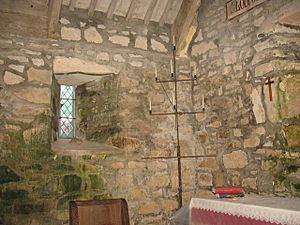Leper window facts for kids
A leper window was a special window found in some churches during the Middle Ages. These windows were built low down in the church wall, usually in the part called the chancel where the altar is. They often had iron bars and shutters. People with leprosy would stand outside and watch the church service, called Mass, through these windows.
Contents
What is a Leper Window?
A leper window is a small opening in the wall of a medieval church. It was placed low enough for someone standing outside to see inside. These windows were designed to be simple and often had strong bars. This allowed people who were not allowed inside the church to still take part in the service.
Why Were They Built?
In the Middle Ages, leprosy was a serious and misunderstood disease. People believed it was very contagious, so those with leprosy were often kept separate from others. They were not allowed to enter churches or mix with healthy people. Leper windows were a way for them to still feel connected to their community and faith. They could watch the Mass and listen to the sermon without coming into close contact with others. This showed a mix of care and fear towards those suffering from the disease.
Other Names for These Windows
Leper windows are also known by other names, like "squints" or "hagioscopes."
- A squint is a general term for any opening in a church wall that lets you see the altar. Not all squints were for lepers. Some were for people in side chapels or other parts of the church who wanted a better view of the main altar.
- A hagioscope is another name for a squint. It comes from Greek words meaning "holy" and "to see." This name highlights the purpose of seeing the holy parts of the church service. While "leper window" specifically points to its use by lepers, "squint" and "hagioscope" describe the physical opening itself.
Images for kids
-
Hagioscope, old church of Saint-Maurice, Freyming-Merlebach, Moselle, France
-
St Bees Priory, Cumbria: Squint window in the wall of chapel built 1270–1300. Window is infilled, but outline is shown, and cross hatch shows wall and floor abutments.
See also
 In Spanish: Hagioscopio para niños
In Spanish: Hagioscopio para niños









